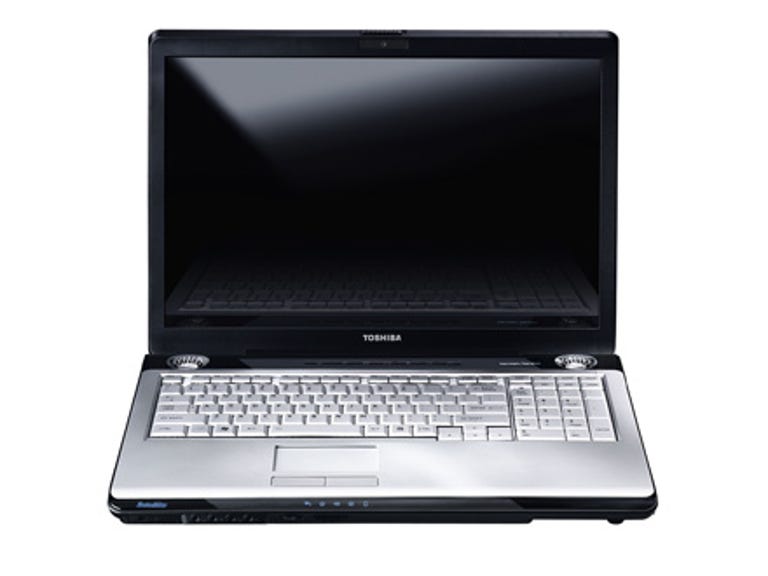 Why You Can Trust CNET
Why You Can Trust CNET Toshiba Satellite P200 review: Toshiba Satellite P200
If you want performance in a desktop replacement form factor then the Toshiba Satellite P200 is a good option, if not a particularly stylish one.
Design
The Toshiba P200 is a desktop replacement which is designed to appeal to home users and occasional gamers. It's a large box at 394mm by 275mm by 41.9mm but it's still relatively portable at only 3.3kg.
The Good
The Bad
The Bottom Line
The Satellite features a large, dark blue cover with a thick hinge that extends across most of the rear of the notebook. As the weakest point in any notebook, such reinforcement makes this model appear all the more sturdy and rugged. The lid itself is curved and it sits out from the back of the monitor - which means there's no room for rear mounted ports.
At a recent event, Toshiba executives told us that the company is busy establishing itself as a premium brand for notebooks, and this includes a focus on prominent branding. This includes a large "Toshiba" on the lid, but one jarring aspect of this approach is the day-glo Satellite logo on the front lip.
Features
The Satellite P200 has its fair share of grunt, and features a top-notch T7400 Intel Core 2 Duo CPU running at 2.16 GHz, a whole 2GB of RAM for better Vista operation, and a roomy 320GB of storage space (two 160GB drives).
The Toshiba packs a decent amount of multimedia features onboard, which includes a set of decent quality (for a notebook) Harman/Kardon speakers -- though the clear, plastic covers feel a bit flimsy -- and playback controls. On the front edge of the notebook resides a wireless on/off switch, a 6-in-1 card reader, headphone and microphone ports and a volume dial.
The 17-inch screen is wide and bright, but like most notebook monitors there isn't much contrast there -- especially in low light. DVD movies look OK when played back via the DVD SuperMulti drive, and colours are clear and well-saturated.
Unlike its stablemate the Qosmio, the Satellite doesn't have any digital outputs -- no HDMI, digital audio or even DVI. This excludes using the notebook as part of a media centre solution, as there's also no remote control. The Qosmio's the better bet, there.
Otherwise, the Toshiba includes four side-mounted USB ports, an S-Video out, VGA-out, 10/100 Ethernet, 802.11-n (draft) and a mini-Firewire port.
We've seen some full-size notebooks which include both an ExpressCard slot and the older PCMCIA -- which is great for users who have lots of existing expansion cards -- but unfortunately not the Satellite P200. It's ExpressCard only.
The trackpad features a metallic finish, as does the keyboard, and features Dual Mode operation with touchpad shortcuts for those that use them (anyone?)
The keyboard is comfortable to type on, although you may find the metallic coating grates a little on the side of your thumb when you hit the spacebar. Lastly, there is also a biometric fingerprint reader for extra peace of mind.
Performance
This notebook is an unashamed desktop replacement and the pattern for a device of this type is for performance to take preference over portability and battery life. Nevertheless, for a device of its size the amount of juice was decent, with a score of two hours in our Battery Eater Pro reader test.
Performance is key here, though, and we found it performed well in both of our performance benchmarks. In fact, it pulled off one of the highest scores we've seen in a laptop for our PCMark05 test. It even managed to outstrip Dell's gaming monster, the M1710, with a score of 5118 marks. This machine sure can crunch some crazy numbers.
Where the machine falls down a little though, is in the graphics department. Its NVIDIA GeForce Go 7600, while an excellent card for mobile gaming, can't compete with the Dell's superior offering of the GeForce Go 7950. As a result it managed a score of 2201 in 3DMark which means it will play most modern games fine, though you may want ratchet down some of the eye-candy in games like Oblivion.
With Santa Rosa notebooks only weeks away from shipping, now is not the best time to invest in a new notebook. New chipsets usually push down the prices of existing stock and this notebook, with its smattering of Santa Rosa-like features, will be more compelling with a price drop.
(Longer bars indicate better performance.)
(Longer bars indicate better performance.)


